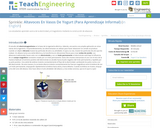
Los estudiantes aprenden acerca de la electricidad y el magnetismo mediante la construcción de altavoces
- Subject:
- Applied Science
- Engineering
- Material Type:
- Activity/Lab
- Provider:
- TeachEngineering
- Provider Set:
- Sprinkles
- Date Added:
- 01/01/2015

Los estudiantes aprenden acerca de la electricidad y el magnetismo mediante la construcción de altavoces

An overview of altering tables after creation

This activity is a debate on alternative energy sources.
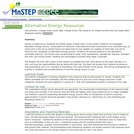
This activity is a cooperative learning experience investigating alternative energy resources.

Introduce graduate students and faculty in any discipline to the world of altmetrics and new ways to evaluate engagement with scholarly publications. The intention is to show not only new measurement techniques but to walk the learners through how to present their work in venues that will increase the visibility of their ideas and scholarly output.

This resource is a video abstract of a research paper created by Research Square on behalf of its authors. It provides a synopsis that's easy to understand, and can be used to introduce the topics it covers to students, researchers, and the general public. The video's transcript is also provided in full, with a portion provided below for preview:
"When patients undergo general anesthesia, there’s a shift in the distribution of ventilation and perfusion throughout the lung, with more areas of the lung getting too much air, relative to the amount of blood flow, and others getting too little. This type of scatter is traditionally described by Riley’s three-compartment model, in which high-ratio lung regions getting less blood flow produce increases in the alveolar deadspace. But new work published in the journal Anesthesiology shows that this model fails to account for different blood solubilities of various anesthetics -- and shows how multicompartment models better predict what is happening in the lungs. The researchers extended an earlier study in anesthetized patients that found that partial pressure measurements of inhaled anesthetic in the lungs did not match those made for carbon dioxide -- and were inconsistent with the three-compartment theory..."
The rest of the transcript, along with a link to the research itself, is available on the resource itself.
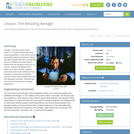
Aerogel, commonly called "frozen smoke," is a super-material with some amazing properties. In this lesson and its associated activity, students learn about this silicon-based solid with a sponge-like structure. Students also learn about density and how aerogel is 99.8% air by volume, making it the lightest solid known to humans! Further, students learn about basic heat transfer and how aerogel is a great thermal insulator, having 39 times more insulation than the best fiberglass insulation. Students also learn about the wide array of aerogel applications.
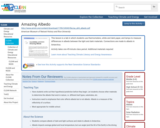
This lesson is a lab in which students use thermometers, white and dark paper, and lamps to measure differences in albedo between the light and dark materials. Connections are made to albedo in Antarctica.
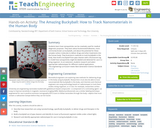
Students learn how nanoparticles can be creatively used for medical diagnostic purposes. They learn about buckminsterfullerenes, more commonly known as buckyballs, and about the potential for these complex carbon molecules to deliver drugs and other treatments into the human body. They brainstorm methods to track buckyballs in the body, then build a buckyball from pipe cleaners with a fluorescent tag to model how nanoparticles might be labeled and detected for use in a living organism. As an extension, students research and select appropriate radioisotopes for different medical applications.

This course will provide an overview of a new vision for Human-Computer Interaction (HCI) in which people are surrounded by intelligent and intuitive interfaces embedded in the everyday objects around them. It will focus on understanding enabling technologies and studying applications and experiments, and, to a lesser extent, it will address the socio-cultural impact. Students will read and discuss the most relevant articles in related areas: smart environments, smart networked objects, augmented and mixed realities, ubiquitous computing, pervasive computing, tangible computing, intelligent interfaces and wearable computing. Finally, they will be asked to come up with new ideas and start innovative projects in this area.
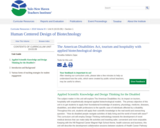
The subject matter in this unit will explore The American Disabilities Act, its impact on tourism, hospitality with empathetically designed applied biotechnological models. The primary objective of this unit is to get students to apply their foundational knowledge of allied health professions to a specified disability.
The curriculum unit was designed and formatted with the intention to give the student a basic understanding of disabilities and to design a rapid prototype with empathy.
Students will apply their scientific knowledge to the real-world and overarching question: “How do disabled people navigate activities of daily living and the world of travel with ease?” This curriculum unit will employ Design Thinking methodology towards the development of novel medical devices that can make daily life activities and traveling safer, convenient and more enjoyable.
The teaching strategies are varied, forward thinking, and promote brainstorming sessions as a means of student engagement. Strategies used will encourage students to think independently and work collaboratively. The curriculum unit framework includes a series of steps, including a complete understanding of the American Disabilities Act, an Everfi-Endeavor STEM careers exploration course that offers a tailored approach to introduce topics relating to Science, Technology, Engineering, Math and Medical Careers, and concludes with a service learning project.
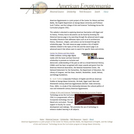
This website is devoted to exploring American fascination with Egypt and its history. Primary Source documents can be found by browsing the Historical Sources page or by searching through the advanced search page. Secondary literature that addresses topics such as art & architecture, history, literature, religion, and science can be browsed through the scholarship page. The web resources page contains a list of helpful websites related to the topics of the site and the search page is an advanced search that allows users to search for specific items and articles.
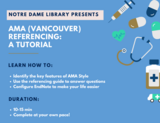
Learn the basics of AMA referencing and how to use EndNote effectively with this style in this 10-15 minute, self-paced tutorial.
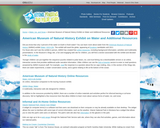
This article highlights resources related to water from the American Museum of Natural History and at-home activities on ice and water.
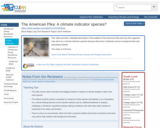
This video provides a detailed description of the habitat of the American Pika and how this organism may serve as a climate indicator species because they have a relatively narrow ecological niche and specialized habitat.
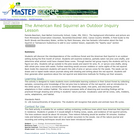
This is outdoor activity involving students in gathering information on what an American Red Squirrel Eats and its interdependence with the coniferous forest.
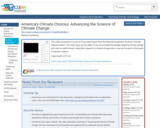
This video production is a part of a four-panel report from the National Academies' America's Climate Choices project. The video maps out the realm of our accumulated knowledge regarding climate change and charts a path forward, urging that research on climate change enter a new era focused on the needs of decision makers.
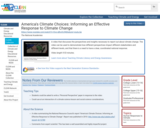
A video that discusses the perspectives and insights necessary to report out about climate change. The video can be used to demonstrate how different perspectives impact different stakeholders and different levels, and that there is a need to have a clear, coordinated national response.
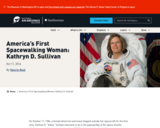
On October 11, 1984, a female American astronaut stepped outside her spacecraft for the first time. Kathryn D. "Kathy" Sullivan had work to do in the payload bay of the Space Shuttle Challenger,

This course discusses the fundamental material science behind amorphous solids, or non-crystalline materials. It covers formation of amorphous solids; amorphous structures and their electrical and optical properties; and characterization methods and technical applications.